Increased Extreme Precipitation in Western North America from Cut-Off Lows Under a Warming Climate
Abstract
1. Introduction
- How will COL frequency and intensity change under the highest forcing scenario (SSP585)?
- How will COL-associated precipitation patterns, including extreme precipitation events, vary seasonally in future climate projections?
- What dynamical processes drive COL changes, and what uncertainties do models present in these projections?
2. Data and Methods
3. Results
3.1. Northern Hemisphere Perspective of Cut-Off Lows
3.2. Cut-Off Low in Western North America
3.2.1. Historical Climate Simulations
3.2.2. Projected Response of the Cut-Off Low Activity and Jet Streams Under a Warming Scenario
3.2.3. Cut-Off Low Related Precipitation Features
3.2.4. Changes in Cut-Off Low Structure
3.2.5. Effect of Climate Warming on the Extreme Precipitation in Cut-Off Lows
4. Discussion and Conclusions
Supplementary Materials
Author Contributions
Funding
Institutional Review Board Statement
Informed Consent Statement
Data Availability Statement
Conflicts of Interest
References
- Ndarana, T.; Waugh, D.W. The link between cut-off lows and Rossby wave breaking in the Southern Hemisphere. Q. J. R. Meteorol. Soc. 2010, 136, 869–885. [Google Scholar] [CrossRef]
- Hoskins, B.J.; McIntyre, M.E.; Robertson, A.W. On the use and significance of isentropic potential vorticity maps. Q. J. R. Meteorol. Soc. 1985, 111, 877–946. [Google Scholar] [CrossRef]
- Davis, C.A.; Emanuel, K.A. Potential vorticity diagnostics of cyclogenesis. Mon. Weather Rev. 1991, 119, 1929–1953. [Google Scholar] [CrossRef]
- Zhao, S.; Sun, J. Study on cut-off low-pressure systems with floods over Northeast Asia. Meteorol. Atmos. Phys. 2007, 96, 159–180. [Google Scholar] [CrossRef]
- Awan, N.K.; Formayer, H. Cutoff low systems and their relevance to large-scale extreme precipitation in the European Alps. Theor. Appl. Climatol. 2017, 129, 149–158. [Google Scholar] [CrossRef]
- Ibebuchi, C.C. Patterns of Atmospheric Circulation in Western Europe Linked to Heavy Rainfall in Germany: Preliminary Analysis into the 2021 Heavy Rainfall Episode. Theor. Appl. Climatol. 2022, 148, 269–283. [Google Scholar] [CrossRef]
- Kramers, T. Multidecadal Analysis of Spatiotemporal Distribution and Severity of Cut-Off Lows Over Europe. Master’s Thesis, Wageningen University & Research, Wageningen, The Netherlands, 2024. [Google Scholar]
- Yamamoto, K.; Iga, K.; Yamazaki, A. Mergers as the maintenance mechanism of cutoff lows: A case study over Europe in July 2021. Mon. Weather Rev. 2024, 152, 1241–1256. [Google Scholar] [CrossRef]
- Bozkurt, D.; Rondanelli, R.; Garreaud, R.; Arriagada, A. Impact of warmer eastern tropical Pacific SST on the March 2015 Atacama floods. Mon. Weather Rev. 2016, 144, 4441–4460. [Google Scholar] [CrossRef]
- Aceituno, P.; Boisier, J.P.; Garreaud, R.; Rondanelli, R.; Rutllant, J.A. Climate and weather in Chile. In Water Resources of Chile; Springer: Cham, Switzerland, 2021; pp. 7–29. [Google Scholar]
- Oakley, N.S.; Redmond, K.T. A climatology of 500-hPa closed lows in the Northeastern Pacific Ocean, 1948–2011. J. Appl. Meteorol. Climatol. 2014, 53, 1578–1592. [Google Scholar] [CrossRef]
- Abatzoglou, J.T. Contribution of cutoff lows to precipitation across the United States. J. Appl. Meteorol. Climatol. 2016, 55, 893–899. [Google Scholar] [CrossRef]
- Barbero, R.; Abatzoglou, J.T.; Fowler, H.J. Contribution of large-scale midlatitude disturbances to hourly precipitation extremes in the United States. Clim. Dyn. 2019, 52, 197–208. [Google Scholar] [CrossRef]
- Oakley, N.S.; Lancaster, J.T.; Hatchett, B.J.; Stock, J.; Ralph, F.M.; Roj, S.; Lukashov, S. A 22-year climatology of cool season hourly precipitation thresholds conducive to shallow landslides in California. Earth Interact. 2018, 22, 1–35. [Google Scholar] [CrossRef]
- Characteristics and Impacts of the April 4–11 2020 Cutoff Low Storm in California. Available online: https://cw3e.ucsd.edu/characteristics-and-impacts-of-the-april-4-11-2020-cutoff-low-storm-in-california/ (accessed on 12 January 2025).
- Kentarchos, A.S.; Davies, T.D. A climatology of cut-off lows at 200 hPa in the Northern Hemisphere, 1990–1994. Int. J. Climatol. 1998, 18, 379–390. [Google Scholar] [CrossRef]
- Sprenger, M.; Wernli, H.; Bourqui, M. Stratosphere–troposphere exchange and its relation to potential vorticity streamers and cutoffs near the extratropical tropopause. J. Atmos. Sci. 2007, 64, 1587–1602. [Google Scholar] [CrossRef]
- Nieto, R.; Sprenger, M.; Wernli, H.; Trigo, R.M.; Gimeno, L. Identification and climatology of cut-off lows near the tropopause. Ann. N. Y. Acad. Sci. 2008, 1146, 256–290. [Google Scholar] [CrossRef]
- Porcù, F.; Carrassi, A.; Medaglia, C.M.; Prodi, F.; Mugnai, A. A study on cut-off low vertical structure and precipitation in the Mediterranean region. Met. Atmos. Phys. 2007, 96, 121–140. [Google Scholar] [CrossRef]
- Fuenzalida, H.A.; Sánchez, R.; Garreaud, R.D. A climatology of cutoff Lows in the Southern Hemisphere. J. Geophys. Res. Atmos. 2005, 110, D18. [Google Scholar] [CrossRef]
- Reboita, M.S.; Nieto, R.; Gimeno, L.; Da Rocha, R.P.; Ambrizzi, T.; Garreaud, R.; Krüger, L.F. Climatological features of cutoff low systems in the Southern Hemisphere. J. Geophys. Res. Atmos. 2010, 115, D17. [Google Scholar] [CrossRef]
- Pinheiro, H.R.; Hodges, K.I.; Gan, M.A.; Ferreira, N.J. A new perspective of the climatological features of upper-level cut-off lows in the Southern Hemisphere. Clim. Dyn. 2017, 48, 541–559. [Google Scholar] [CrossRef]
- Muñoz, C.; Schultz, D.; Vaughan, G. A Midlatitude Climatology and Interannual Variability of 200- and 500-hPa Cut-Off Lows. J. Clim. 2020, 33, 2201–2222. [Google Scholar] [CrossRef]
- Pinheiro, H.R.; Hodges, K.I.; Gan, M.A. Sensitivity of identifying cut-off lows in the Southern Hemisphere using multiple criteria: Implications for numbers, seasonality and intensity. Clim. Dyn. 2019, 53, 6699–6713. [Google Scholar] [CrossRef]
- Pinheiro, H.R.; Hodges, K.I.; Gan, M.A. An intercomparison of subtropical cut-off lows in the Southern Hemisphere using recent reanalyses: ERA-Interim, NCEP-CFRS, MERRA-2, JRA-55, and JRA-25. Clim. Dyn. 2020, 54, 777–792. [Google Scholar] [CrossRef]
- Portmann, R.; Crezee, B.; Quinting, J.; Wernli, H. The complex life cycles of two long-lived potential vorticity cut-offs over Europe. Q. J. R. Meteorol. Soc. 2018, 144, 701–719. [Google Scholar] [CrossRef]
- Pinheiro, H.R.; Hodges, K.I.; Gan, M.A.; Ferreira, S.H.; Andrade, K.M. Contributions of downstream baroclinic development to strong Southern Hemisphere cut-off lows. Q. J. R. Meteorol. Soc. 2022, 148, 214–232. [Google Scholar] [CrossRef]
- Nie, Y.; Wu, J.; Zuo, J.; Ren, H.L.; Scaife, A.A.; Dunstone, N.; Hardiman, S.C. Subseasonal prediction of early-summer Northeast Asian cut-off lows by BCC-CSM2-HR and GloSea5. Adv. Atmos. Sci. 2023, 40, 2127–2134. [Google Scholar] [CrossRef]
- Pinheiro, H.; Ambrizzi, T.; Hodges, K.; Gan, M.; Andrade, K.; Garcia, J. Are Cut-off Lows simulated better in CMIP6 compared to CMIP5? Clim. Dyn. 2022, 59, 2117–2136. [Google Scholar] [CrossRef]
- Pinheiro, H.R.; Ambrizzi, T.; Hodges, K.I.; Gan, M.A. Understanding the El Niño southern oscillation effect on cut-off lows as simulated in forced SST and fully coupled experiments. Atmosphere 2022, 13, 1167. [Google Scholar] [CrossRef]
- Engelbrecht, F.A.; Dyson, L.L. High-resolution model-projected changes in mid-tropospheric closed-lows and extreme rainfall events over southern Africa. Int. J. Climatol. 2013, 33, 173–187. [Google Scholar] [CrossRef]
- Ferreira, R.N. Cut-off lows and extreme precipitation in eastern Spain: Current and future climate. Atmosphere 2021, 12, 835. [Google Scholar] [CrossRef]
- Thompson, V.; Coumou, D.; Galfi, V.M.; Happé, T.; Kew, S.; Pinto, I.; Philip, S.; de Vries, H.; van der Wiel, K. Changing dynamics of Western European summertime cut-off lows: A case study of the July 2021 flood event. Atmos. Sci. Lett. 2024, 25, e1260. [Google Scholar] [CrossRef]
- Mishra, A.N.; Maraun, D.; Schiemann, R.; Hodges, K.; Zappa, G. Climate Change’s Influence on Cut-off Lows in the Future. In Proceedings of the EGU General Assembly 2024, EGU24-19896. Vienna, Austria, 14–19 April 2024. [Google Scholar] [CrossRef]
- Pinheiro, H.R.; Hodges, K.I.; Gan, M.A. Deepening mechanisms of cut-off lows in the Southern Hemisphere and the role of jet streams: Insights from eddy kinetic energy analysis. Weather Clim. Dynam. 2024, 5, 881–894. [Google Scholar] [CrossRef]
- Eyring, V.; Bony, S.; Meehl, G.A.; Senior, C.A.; Stevens, B.; Stouffer, R.J.; Taylor, K.E. Overview of the Coupled Model Intercomparison Project Phase 6 (CMIP6) experimental design and organization. Geosci. Model Dev. 2016, 9, 1937–1958. [Google Scholar] [CrossRef]
- Hersbach, H. ERA5 reanalysis is in production. ECMWF Newsl. 2016, 147, 5. [Google Scholar]
- Hodges, K.I. Feature tracking on the unit sphere. Mon. Weather Rev. 1995, 123, 3458–3465. [Google Scholar] [CrossRef]
- Hodges, K.I. Adaptive constraints for feature tracking. Mon. Weather Rev. 1999, 127, 1362–1373. [Google Scholar] [CrossRef]
- Hodges, K.I. Spherical nonparametric estimators applied to the UGAMP model integration for AMIP. Mon. Weather Rev. 1996, 124, 2914–2932. [Google Scholar] [CrossRef]
- Bengtsson, L.; Hodges, K.I.; Esch, M.; Keenlyside, N.; Kornblueh, L.; Luo, J.J.; Yamagata, T. How may tropical cyclones change in a warmer climate? Tellus A Dyn. Meteorol. Oceanogr. 2007, 59, 539–561. [Google Scholar] [CrossRef]
- Bengtsson, L.; Hodges, K.I.; Keenlyside, N. Will extratropical storms intensify in a warmer climate? J. Climate 2009, 22, 2276–2301. [Google Scholar] [CrossRef]
- Pinheiro, H.; Gan, M.; Hodges, K. Structure and evolution of intense austral cut-off lows. Q. J. R. Meteorol. Soc. 2021, 147, 1–20. [Google Scholar] [CrossRef]
- Portmann, R.; Sprenger, M.; Wernli, H. The three-dimensional life cycles of potential vorticity cutoffs: A global and selected regional climatologies in ERA-Interim (1979–2018). Weather Clim. Dynam. 2021, 2, 507–534. [Google Scholar] [CrossRef]
- Wang, Y.; Hu, K.; Huang, G.; Tao, W. Asymmetric impacts of El Niño and La Niña on the Pacific–North American teleconnection pattern: The role of subtropical jet stream. Environ. Res. Lett. 2021, 16, 114040. [Google Scholar] [CrossRef]
- Harvey, B.J.; Cook, P.; Shaffrey, L.C.; Schiemann, R. The response of the northern hemisphere storm tracks and jet streams to climate change in the CMIP3, CMIP5, and CMIP6 climate models. J. Geophys. Res. Atmos. 2020, 125, e2020JD032701. [Google Scholar] [CrossRef]
- Hawcroft, M.K.; Shaffrey, L.C.; Hodges, K.I.; Dacre, H.F. Can climate models represent the precipitation associated with extratropical cyclones? Clim. Dyn. 2016, 47, 679–695. [Google Scholar] [CrossRef]
- Hawcroft, M.; Dacre, H.; Forbes, R.; Hodges, K.; Shaffrey, L.; Stein, T. Using satellite and reanalysis data to evaluate the representation of latent heating in extratropical cyclones in a climate model. Clim. Dyn. 2017, 48, 2255–2278. [Google Scholar] [CrossRef]
- Adams, D.K.; Comrie, A.C. The north American monsoon. Bull. Am. Meteorol. Soc. 1997, 78, 2197–2214. [Google Scholar] [CrossRef]
- Stoelinga, M.T. A potential vorticity-based study of the role of diabatic heating and friction in a numerically simulated baroclinic cyclone. Mon. Weather Rev. 1996, 124, 849–874. [Google Scholar] [CrossRef]
- Cavallo, S.M.; Hakim, G.J. Composite structure of tropopause polar cyclones. Mon. Weather Rev. 2010, 138, 3840–3857. [Google Scholar] [CrossRef]
- Herger, N.; Abramowitz, G.; Knutti, R.; Angélil, O.; Lehmann, K.; Sanderson, B.M. Selecting a climate model subset to optimise key ensemble properties. Earth Syst. Dyn. 2018, 9, 135–151. [Google Scholar] [CrossRef]
- Lee, J.; Planton, Y.Y.; Gleckler, P.J.; Sperber, K.R.; Guilyardi, E.; Wittenberg, A.T.; McPhaden, M.J.; Pallotta, G. Robust evaluation of ENSO in climate models: How many ensemble members are needed? Geophys. Res. Lett. 2021, 48, e2021GL095041. [Google Scholar] [CrossRef]
- Godoy, A.A.; Possia, N.E.; Campetella, C.M.; García Skabar, Y. A cut-off low in southern South America: Dynamic and thermodynamic processes. Rev. Bras. Meteorol. 2011, 26, 503–514. [Google Scholar] [CrossRef]
- Li, J.L.; Xu, K.M.; Jiang, J.H.; Lee, W.L.; Wang, L.C.; Yu, J.Y.; Stephens, G.; Fetzer, E.; Wang, Y. An overview of CMIP5 and CMIP6 simulated cloud ice, radiation fields, surface wind stress, sea surface temperatures, and precipitation over tropical and subtropical oceans. J. Geophys. Res. Atmos. 2020, 125, e2020JD032848. [Google Scholar] [CrossRef]
- Priestley, M.D.; Ackerley, D.; Catto, J.L.; Hodges, K.I. Drivers of biases in the CMIP6 extratropical storm tracks. Part I: Northern Hemisphere. J. Clim. 2023, 36, 1451–1467. [Google Scholar] [CrossRef]
- Sun, C.; Liang, X.Z. Understanding and reducing warm and dry summer biases in the central United States: Analytical modeling to identify the mechanisms for CMIP ensemble error spread. J. Clim. 2023, 36, 2035–2054. [Google Scholar] [CrossRef]
- Haarsma, R.J.; Roberts, M.J.; Vidale, P.L.; Senior, C.A.; Bellucci, A.; Bao, Q.; Chang, P.; Corti, S.; Fučkar, N.S.; Guemas, V.; et al. High resolution model intercomparison project (HighResMIP v1.0) for CMIP6. Geosci. Model Dev. 2016, 9, 4185–4208. [Google Scholar] [CrossRef]
- Yazdandoost, F.; Moradian, S.; Izadi, A.; Aghakouchak, A. Evaluation of CMIP6 precipitation simulations across different climatic zones: Uncertainty and model intercomparison. Atmos. Res. 2021, 250, 105369. [Google Scholar] [CrossRef]
- John, A.; Douville, H.; Ribes, A.; Yiou, P. Quantifying CMIP6 model uncertainties in extreme precipitation projections. Weather Clim. Extrem. 2022, 36, 100435. [Google Scholar] [CrossRef]
- Schär, C.; Fuhrer, O.; Arteaga, A.; Ban, N.; Charpilloz, C.; Di Girolamo, S.; Hentgen, L.; Hoefler, T.; Lapillonne, X.; Leutwyler, D.; et al. Kilometer-scale climate models: Prospects and challenges. Bull. Am. Meteorol. Soc. 2020, 101, E567–E587. [Google Scholar] [CrossRef]
- The Fast Development of DestinE’s Climate Change Adaptation Digital Twin. Available online: https://destine.ecmwf.int/news/the-fast-development-of-destines-climate-change-adaptation-digital-twin/ (accessed on 21 January 2025).
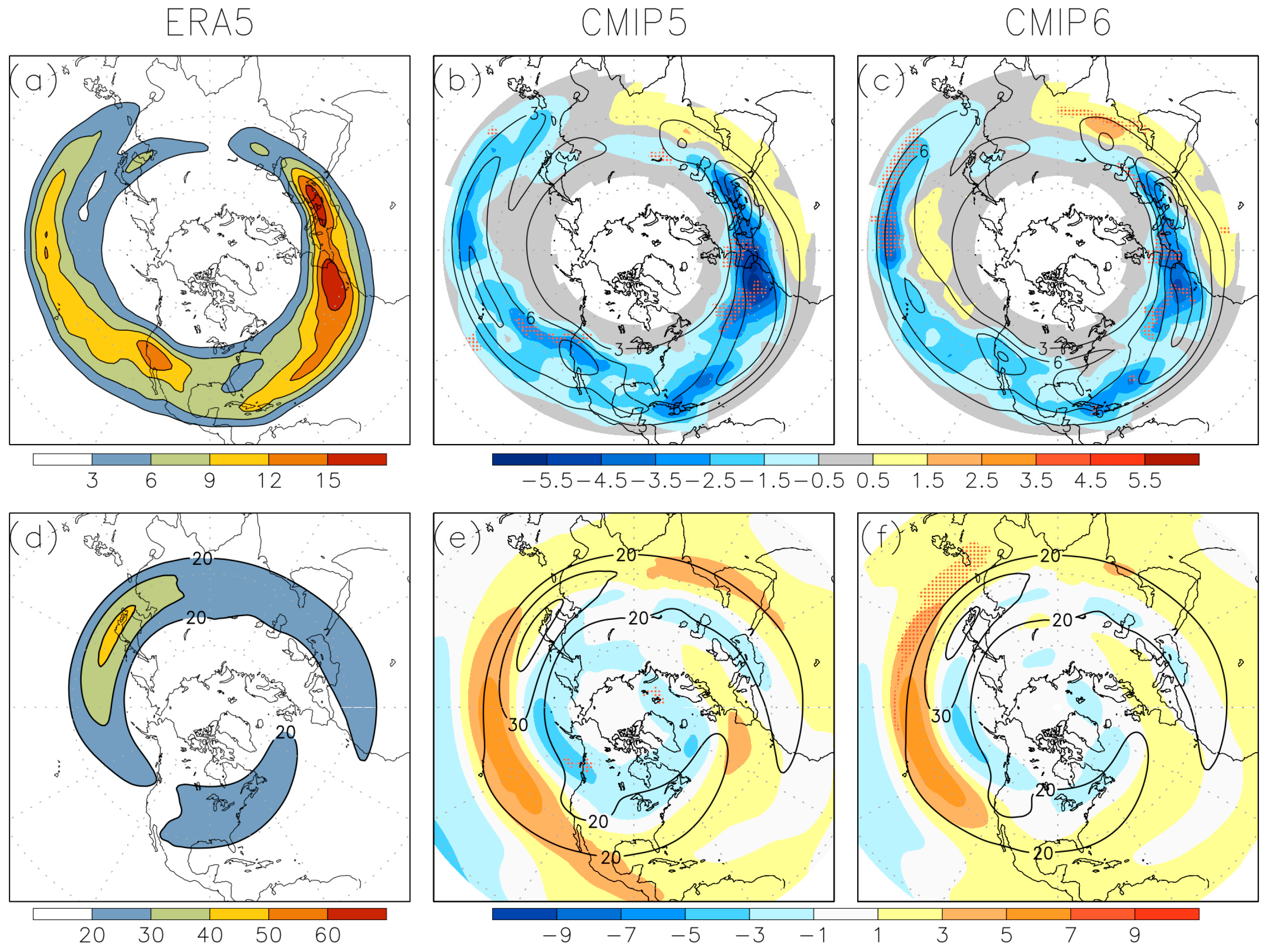
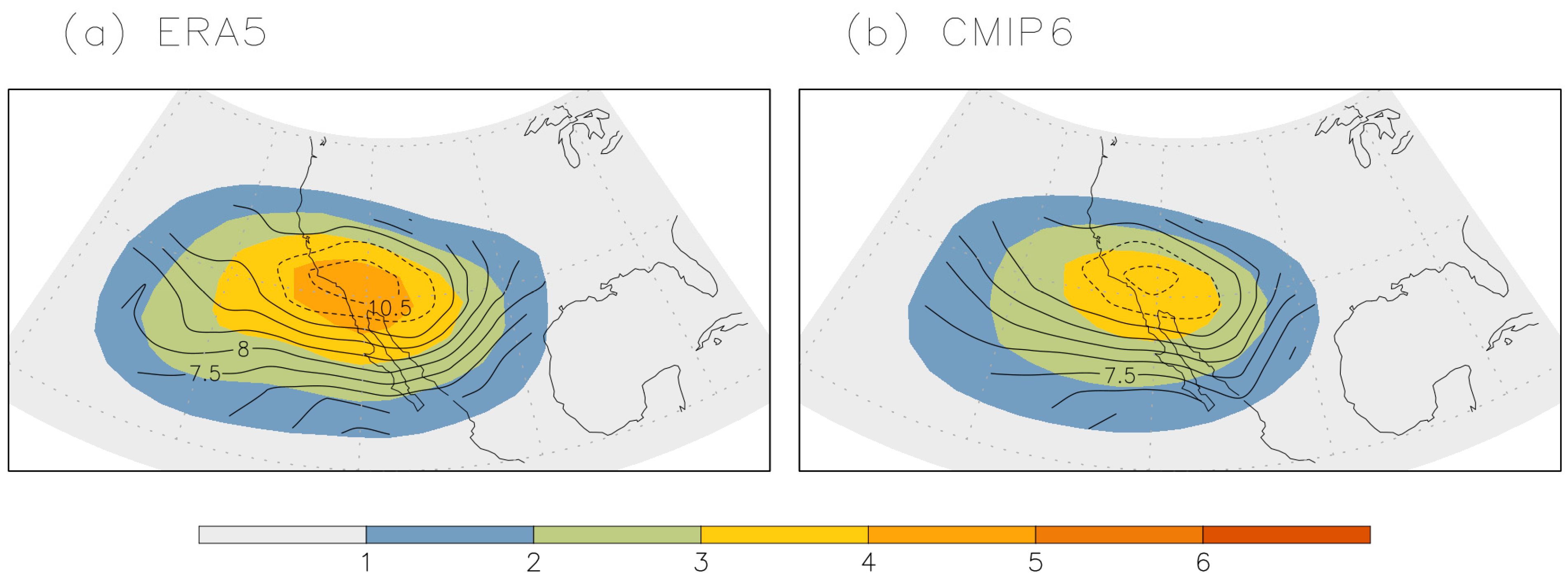

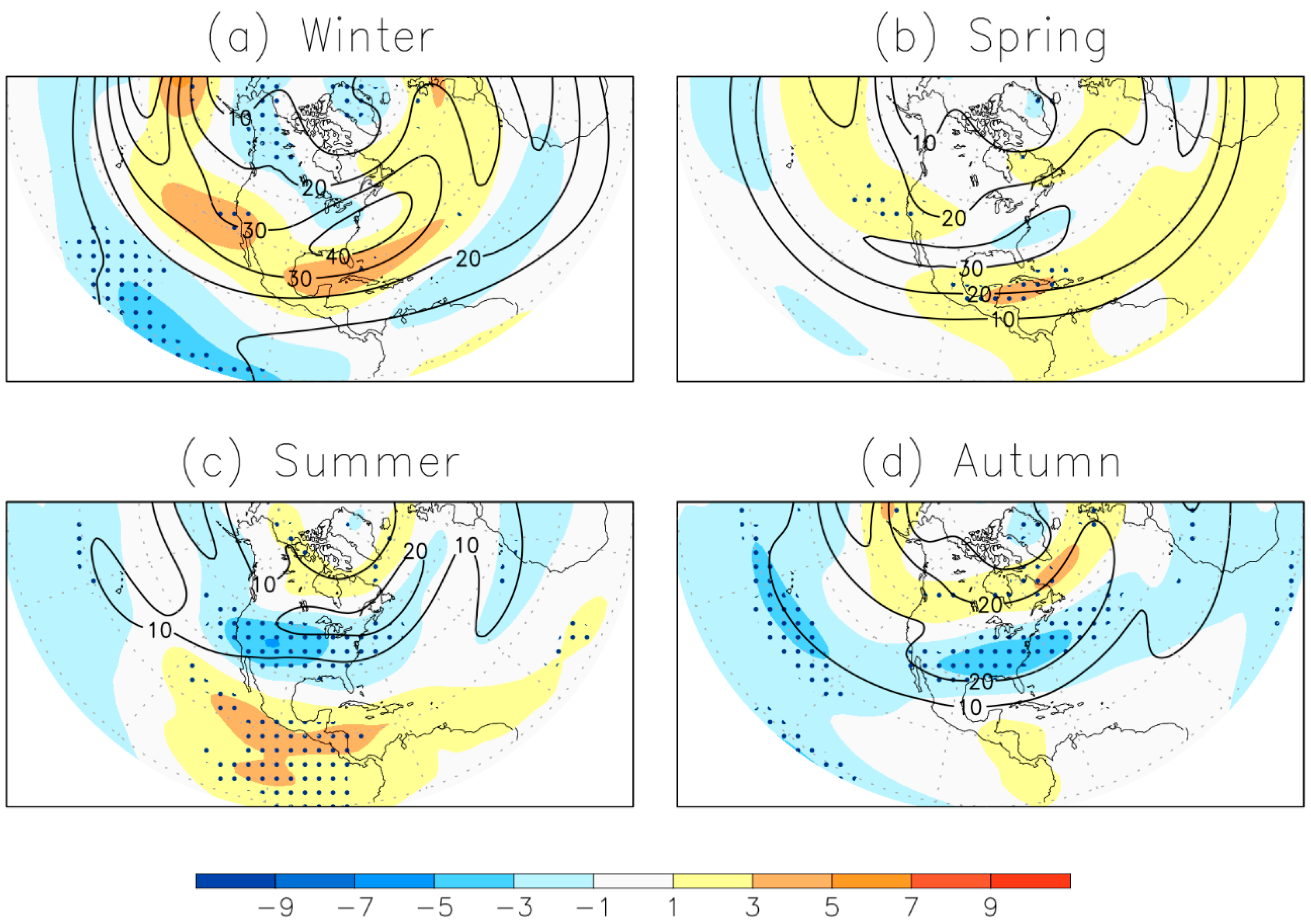

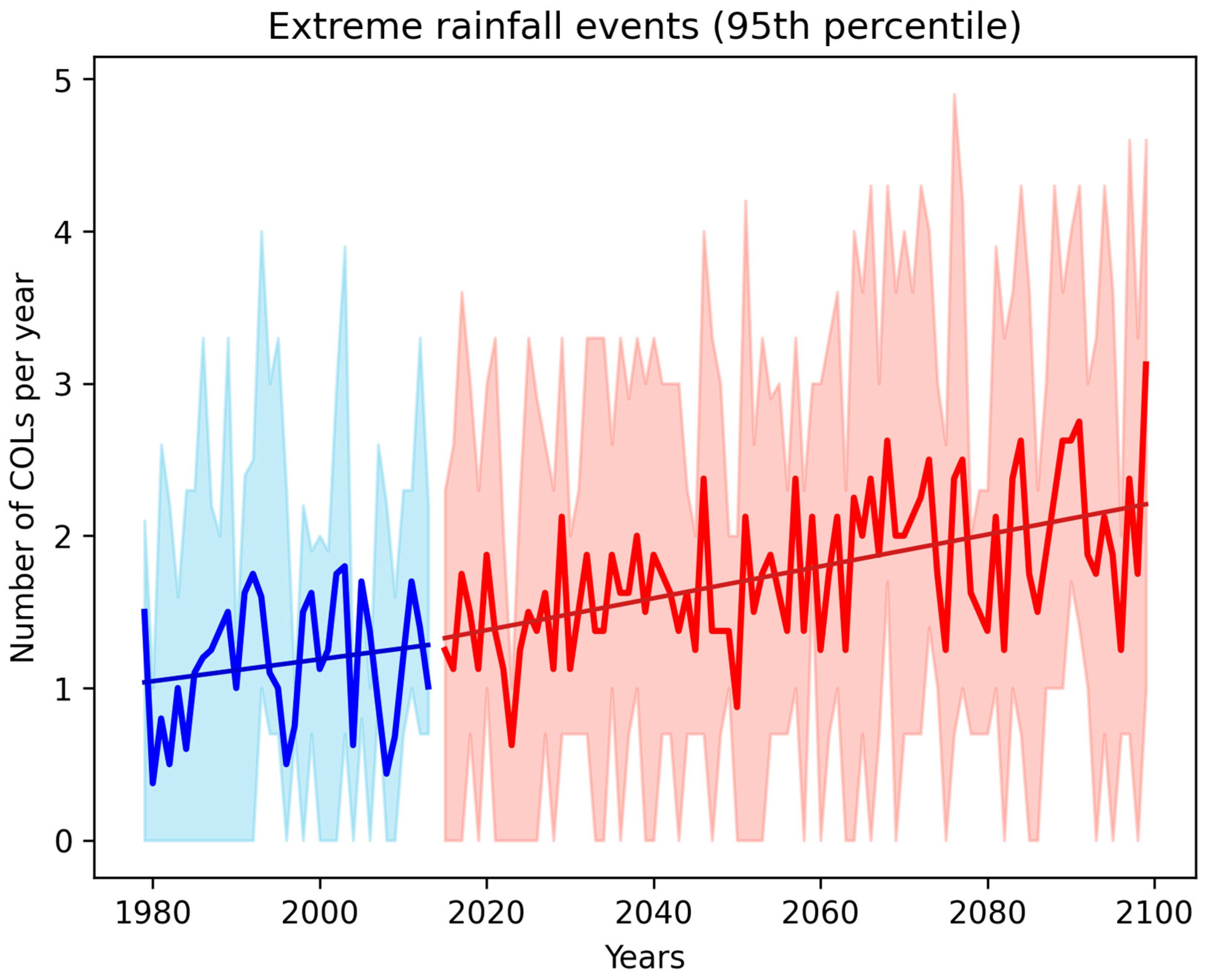
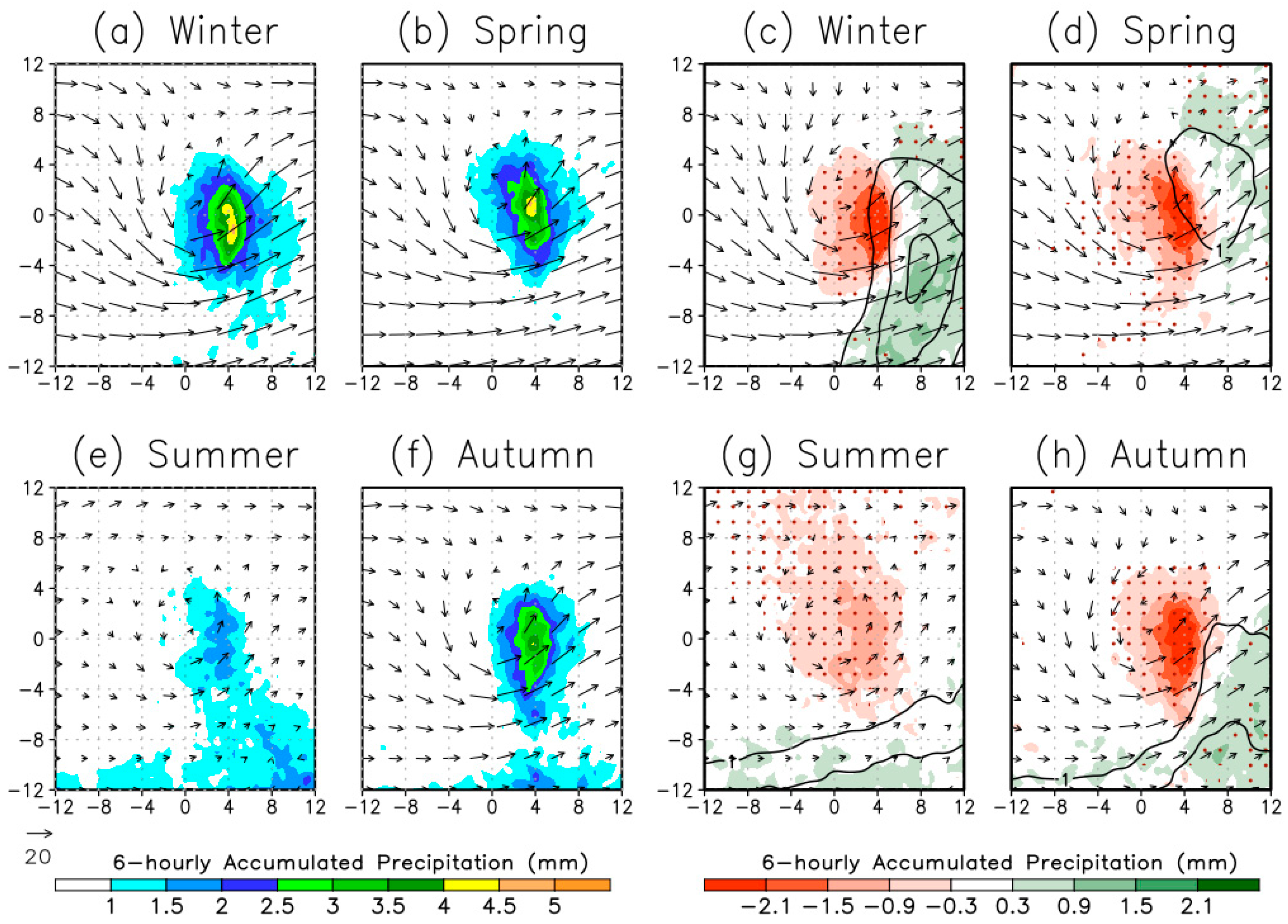

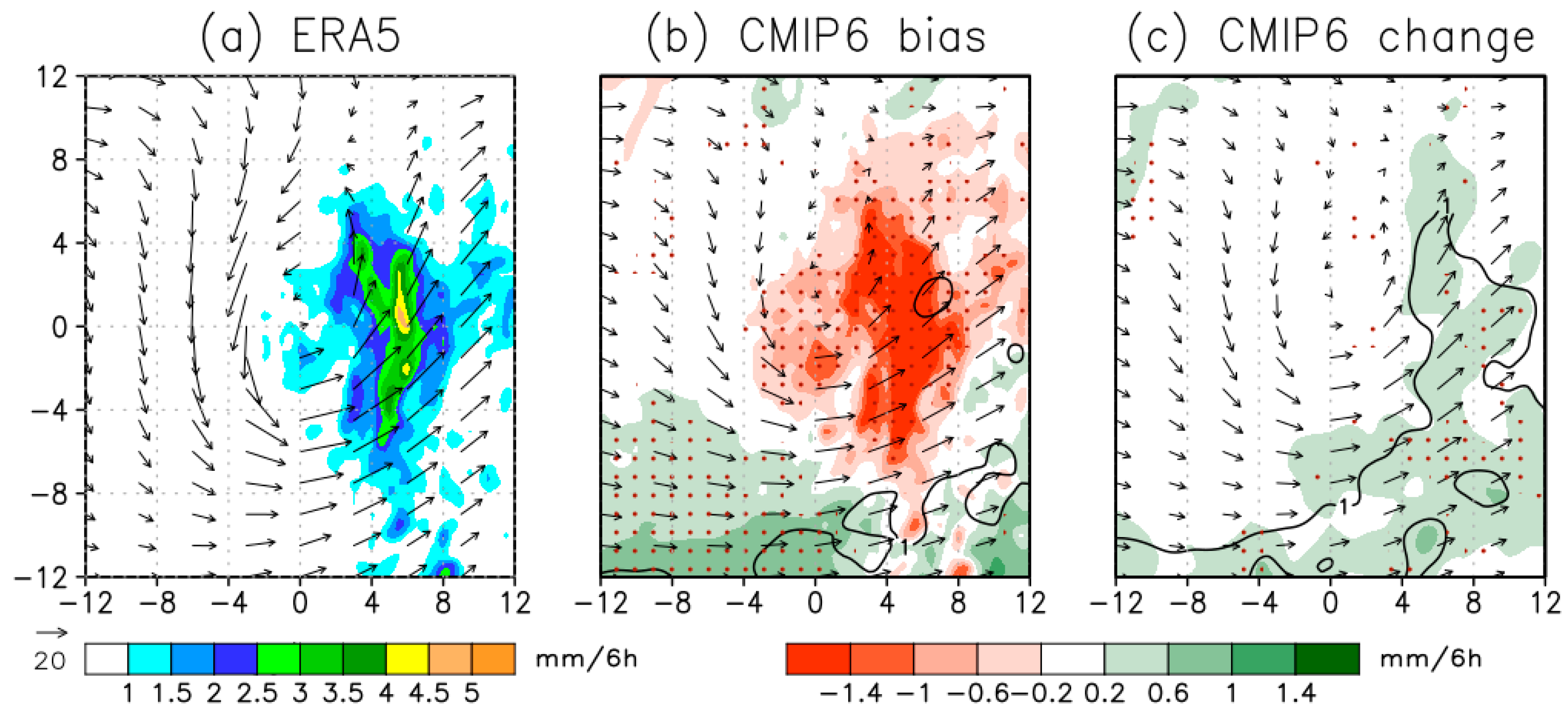
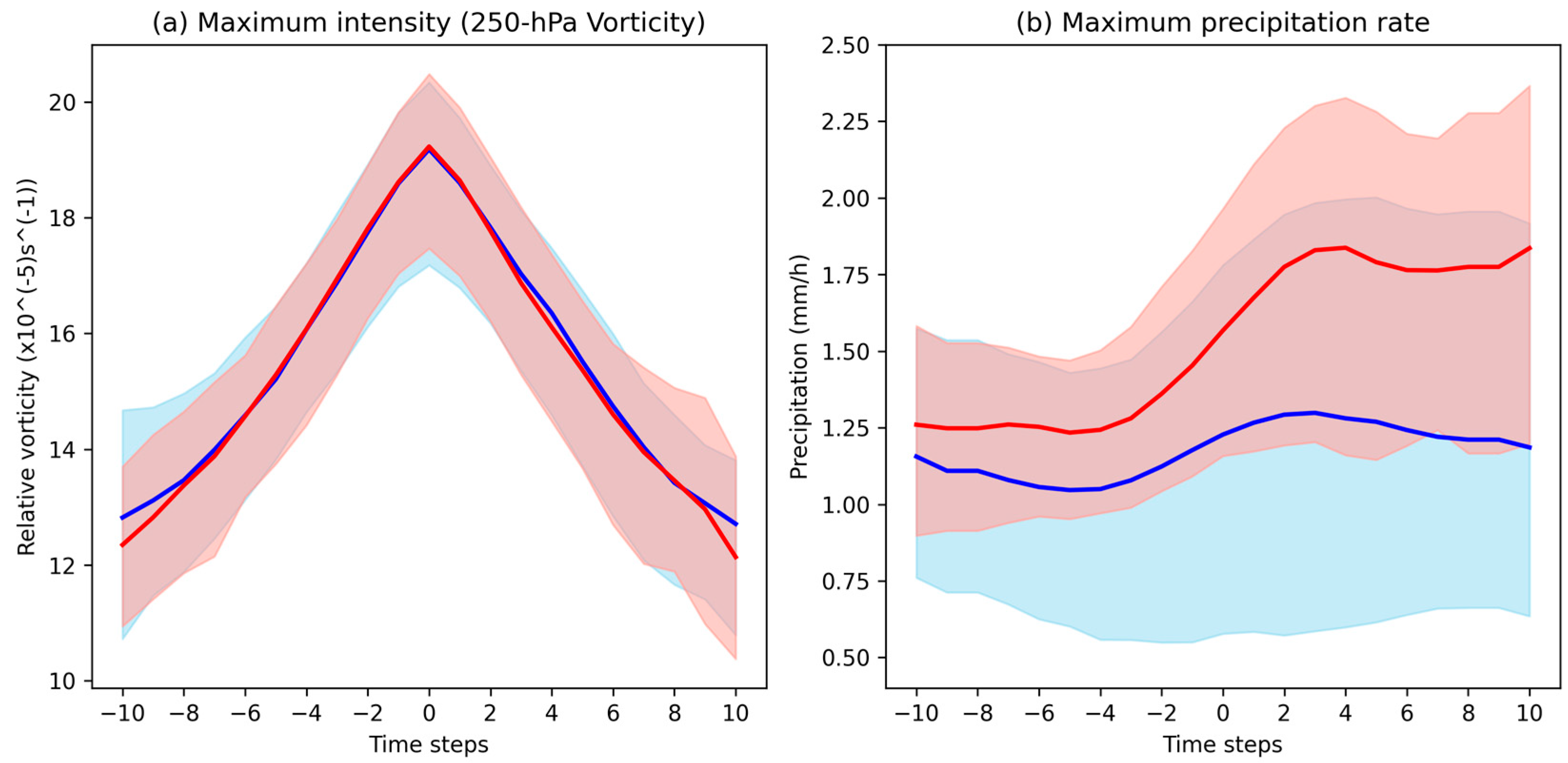
| Model | Institute | Resolution | Tracks per Season | |
|---|---|---|---|---|
| 1980–2009 | 2070–2099 | |||
| ACCESS-CM2 | CSIRO, Australia | 192 × 145 (250 km) | 10.1 | 9.8 |
| BCC-CSM2-MR | BCC, China | 320 × 160 (100 km) | 11.8 | 11.8 |
| CNRM-CM6-1-HR | CNRM, France | 720 × 360 (50 km) | 15.6 | 13.2 |
| MIROC-ES2L | MIROC, Japan | 128 × 64 (500 km) | 10.1 | 9.0 |
| MPI-ESM1-2-HR | MPI, Germany | 384 × 192 (100 km) | 10.5 | 10.7 |
| MRI-ESM2-0 | MRI, Japan | 320 × 160 (100 km) | 10.3 | 9.8 |
| NESM3 | NUIST, China | 192 × 96 (250 km) | 9.8 | 9.1 |
| NorESM2-LM | NCC, Norway | 144 × 96 (250 km) | 6.9 | 7.4 |
| CMIP6 mean | 10.6 | 10.1 | ||
| ERA5 | ECMWF, Europe | 1440 × 721 (31 km) | 12.3 | - |
Disclaimer/Publisher’s Note: The statements, opinions and data contained in all publications are solely those of the individual author(s) and contributor(s) and not of MDPI and/or the editor(s). MDPI and/or the editor(s) disclaim responsibility for any injury to people or property resulting from any ideas, methods, instructions or products referred to in the content. |
© 2025 by the authors. Licensee MDPI, Basel, Switzerland. This article is an open access article distributed under the terms and conditions of the Creative Commons Attribution (CC BY) license (https://creativecommons.org/licenses/by/4.0/).
Share and Cite
Pinheiro, H.; Ambrizzi, T.; Hodges, K. Increased Extreme Precipitation in Western North America from Cut-Off Lows Under a Warming Climate. Meteorology 2025, 4, 11. https://doi.org/10.3390/meteorology4020011
Pinheiro H, Ambrizzi T, Hodges K. Increased Extreme Precipitation in Western North America from Cut-Off Lows Under a Warming Climate. Meteorology. 2025; 4(2):11. https://doi.org/10.3390/meteorology4020011
Chicago/Turabian StylePinheiro, Henri, Tercio Ambrizzi, and Kevin Hodges. 2025. "Increased Extreme Precipitation in Western North America from Cut-Off Lows Under a Warming Climate" Meteorology 4, no. 2: 11. https://doi.org/10.3390/meteorology4020011
APA StylePinheiro, H., Ambrizzi, T., & Hodges, K. (2025). Increased Extreme Precipitation in Western North America from Cut-Off Lows Under a Warming Climate. Meteorology, 4(2), 11. https://doi.org/10.3390/meteorology4020011






